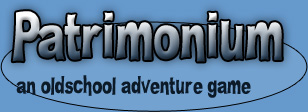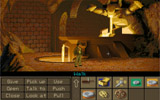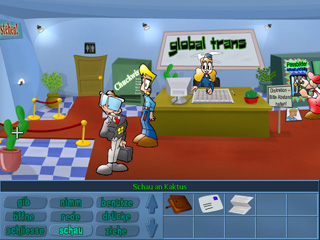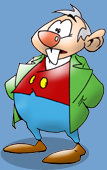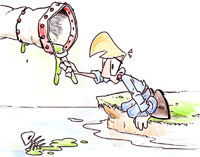
'Patrimonium' is a classical 2D-graphic adventure. It is also called a fanadventure because is developed by fans of the adventure genre. Their normal jobs have nothing to do with game development. On the 'Patrimonium' homepage we will offer free download of the game after it has been translated into english.
The game is meant to be a tribute to the adventure genre. It has to be available to everybody for free, it should entertain, it should be a challenge and it should also remind the fans on the 'good old days' of the graphic adventures. It should give a taste of adventure games to players not familiar with the genre and last but not least it should tell a unique story and convey a one-off game expierence.
|
||||||||||
| Screenshot from 'Patrimonium' |

After the first steps of orientation in the fields of graphics and programming, we started the design and development in 2003. After the first three of 5 acts (we scheduled) were finished, we published these immediately to see the reaction of the players and to get a feedback. Lots of the feedbacks and emails from the players and also the positive reaction of the press strongly motivated us to go on with 'Patromonium' and to keep our high quality standard.
|
Commercially, the adventure genre boomed again since the beginning of the new millennium. The commercial success of 'Runaway', the bearer of hope at the time,
changed the interest of publishers in adventure games to the better. Some insiders of the scene speculated that in reality 'Patromium' is responsible. The counter evidence isn't written yet. ;-)
|
Between 2001 and 2003, the main features of the story of the game arose during the phase of concept and orientation.
It is the result of ideas from the brains of Bernhard Altaner, Stefan Pflüger and Jonas Jelli. Sadly Bernhard and Stefan left our team early as well as Alan Smithee who contributed most of the background music.
On the basis of the storyline, some of the puzzles found their way into the game after a bit of brainstorming.
Many were created and enhanced during the introduction of the resources into the game and the following audition of the game.
Details like monologues, dialogues, description of the objects in the game and additional interactions with the world of the game as well as
the reaction to it, are developed spontaneously. After a few auditions they are refined and coordinated to provide a logical background story.
In the story page of our homepage, you will find a short marking out of the epic
background story of 'Patrimonium' and an introduction of the most important characters in the story.
|
To program the game we use the so called 'Adventure Game Authoring Sytem' (AGAST). AGAST is a flexible, powerful and elegant tool, which is specialised in the development of graphic adventures.
If it is used for non-commercial use it is freeware.
|
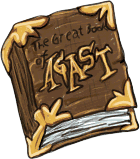
|

Some special features and quality characteristics are listed as follows...
| ||||||||||||||||||||||||
[1] At this point we would like to explain the concept of the so called 'Puja-Tips' more detailed. From time to time it happens that adventure players stuck at one or more places in the game.
The solution of the puzzle they are confronted with doesn't open up that easily. Some players take resort in walkthroughs and others start to combine chaoticly.
|
Occationally the puzzles in 'Patrimonium' can be very difficult. For that reason we try to adjust the standards of tricky situations in the
game to the power of deduction of the player. The game recognizes how often a player tries to approach a certain puzzle and reduces the
level of difficulty automatically. Therefore the protagonist releases clearer ('Puja'-) tips more often, which should help the player to go back on track.
Or, after each failing, in puzzles, which need a timed coordination more and more time is provided to the player.
|

|
In general 'Patrimonium' should be playable on all modern PC systems. However, if you have an older computer and you are not sure if the game will run on it please see the following minimal system requirements.
|
|
For the background music and the sound effects a Soundblaster compatible sound card should be installed on your computer
Reportedly 'Patrimonium' runs on Linux as well (no guarantee). To do so install Wine and Cedega and add subsequently to the configuration file (/home/username/.cvscedega/config or /home/username/.wine/config)) the following lines at any place:
[d3dgl] "ClipSpaceFix" = "N"
